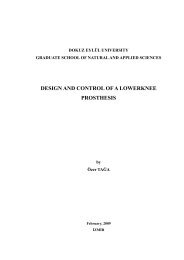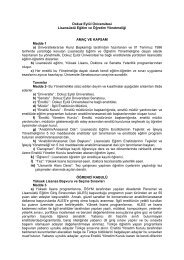A numerical study on the thermal expansion coefficients of fiber
A numerical study on the thermal expansion coefficients of fiber
A numerical study on the thermal expansion coefficients of fiber
Create successful ePaper yourself
Turn your PDF publications into a flip-book with our unique Google optimized e-Paper software.
49<br />
Argyris in 1955 <strong>on</strong> energy <strong>the</strong>orems and matrix methods laid a foundati<strong>on</strong> for fur<strong>the</strong>r<br />
developments in finite element studies. The first book <strong>on</strong> finite elements by<br />
Zienkiewicz and Chung was published in 1967. In <strong>the</strong> late 1960s and early 1970s,<br />
finite element analysis was applied to n<strong>on</strong>linear problems and large deformati<strong>on</strong>s.<br />
Oden’s book <strong>on</strong> n<strong>on</strong>linear c<strong>on</strong>tinua appeared in 1972. Ma<strong>the</strong>matical foundati<strong>on</strong>s<br />
were laid in <strong>the</strong>1970s. New element development, c<strong>on</strong>vergence studies, and o<strong>the</strong>r<br />
related areas are in this category. Today, <strong>the</strong> developments in main frame computers<br />
and availability <strong>of</strong> powerful microcomputers has brought this method within reach <strong>of</strong><br />
students and engineers working in small industries (Chandrupatla, & Belegundu,<br />
2002).<br />
4.2 Finite Element Analysis Procedure<br />
4.2.1 Geometry Creati<strong>on</strong><br />
The first step in <strong>the</strong> finite element analysis procedure is to model <strong>the</strong> part<br />
geometry. There are many ways to define geometry, ranging from two-dimensi<strong>on</strong>al<br />
drawings to three-dimensi<strong>on</strong>al computer-aided design. Computer-aided drafting<br />
permits easy generati<strong>on</strong> and editing <strong>of</strong> two-dimensi<strong>on</strong>al geometry. In general, this<br />
process involves placing lines, rectangles, arcs, circles, and o<strong>the</strong>r basic<br />
geometric shapes <strong>on</strong> a display screen and <strong>the</strong>n moving, rotating, and scaling<br />
<strong>the</strong>se shapes to define a part outline. Often, <strong>the</strong>re is a need to describe a part in<br />
three dimensi<strong>on</strong>s so that it can be more easily understood and c<strong>on</strong>verted to a<br />
discretized finite-element definiti<strong>on</strong>. Wireframe modeling is <strong>the</strong> simplest approach<br />
to graphical display <strong>of</strong> three-dimensi<strong>on</strong>al shapes by definiti<strong>on</strong> <strong>of</strong> part outlines and<br />
intersecti<strong>on</strong>s <strong>of</strong> surfaces. Unfortunately, <strong>the</strong>se models can be obscure and difficult<br />
to visualize. Surface modeling goes <strong>on</strong>e step bey<strong>on</strong>d wireframes by describing <strong>the</strong><br />
individual surfaces <strong>of</strong> <strong>the</strong> model, analogous to stretching a thin fabric over <strong>the</strong><br />
wireframe model. Solid models provide <strong>the</strong> most accurate descripti<strong>on</strong> <strong>of</strong> part<br />
geometry by ma<strong>the</strong>matically describing <strong>the</strong> interior and exterior <strong>of</strong> <strong>the</strong> part<br />
(Trantina, & Nimmer, 1994).

















